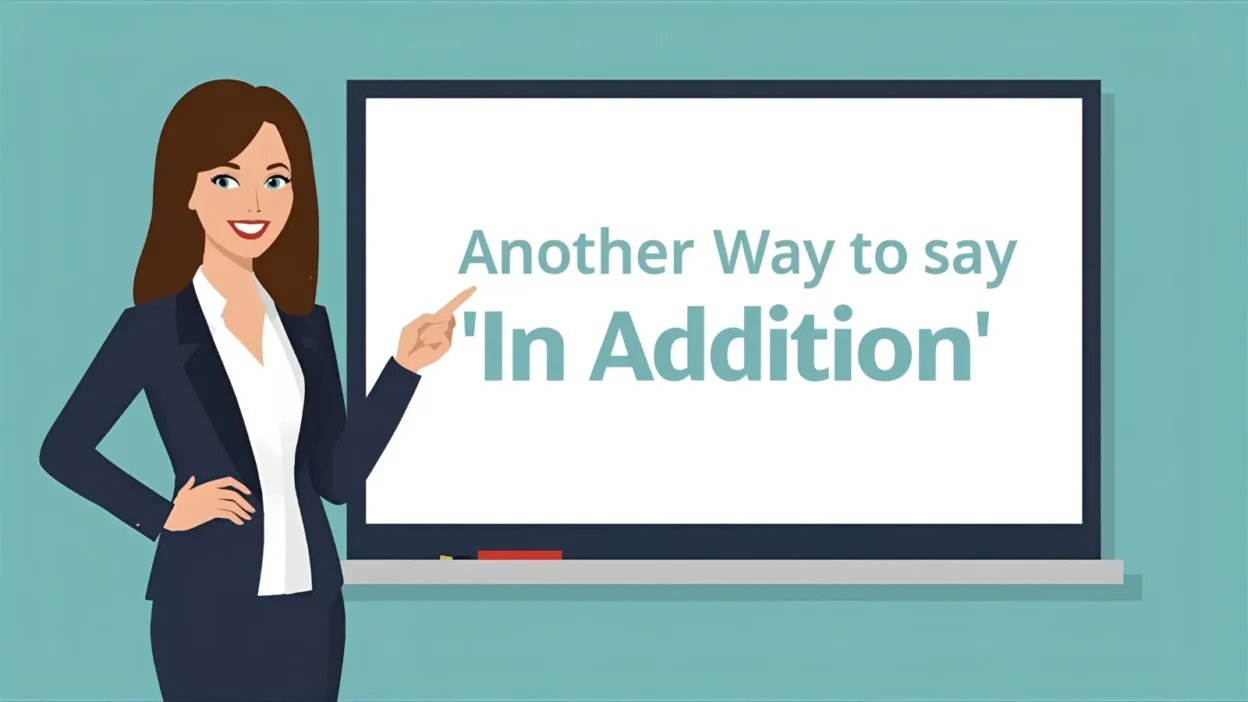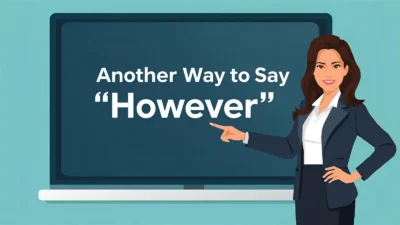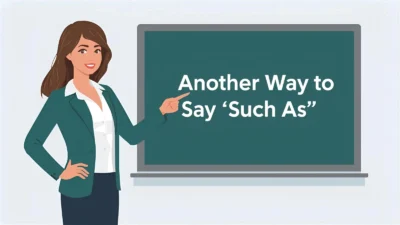The phrase “in addition” is a reliable way to connect ideas, add extra information, or build on an argument. It’s clear and effective, but overusing it can make writing sound repetitive or predictable. Having a variety of alternatives not only strengthens your style but also helps you adapt to formal, casual, persuasive, or creative contexts.
In this article, you’ll discover 25 useful alternatives to “in addition”—each explained with meaning, detailed usage, example, best context, and tone—so you can enrich your writing and communication.
1. Additionally
Meaning: Adds another point or piece of information.
Detailed Explanation: A direct synonym, often used in professional and academic writing.
Scenario Example: Additionally, the company will expand into new markets next year.
Best Use: Business reports, research, essays.
Tone: Formal, polished.
2. Moreover
Meaning: Strengthens an argument by adding supporting information.
Detailed Explanation: Slightly more formal than “in addition,” showing logical build-up.
Scenario Example: Moreover, this approach reduces costs by 15%.
Best Use: Persuasive writing, formal contexts.
Tone: Assertive, academic.
3. What’s more
Meaning: Adds extra emphasis in a conversational way.
Detailed Explanation: Common in speech and informal writing to show enthusiasm.
Scenario Example: The hotel was affordable, and what’s more, it had amazing service.
Best Use: Blogs, casual talks, friendly explanations.
Tone: Conversational, lively.
4. As well
Meaning: Indicates something is included alongside another.
Detailed Explanation: Simple and versatile alternative, softer than “in addition.”
Scenario Example: She speaks French and German as well.
Best Use: Everyday speech, semi-formal writing.
Tone: Neutral, flexible.
5. Along with
Meaning: Shows something accompanying another point.
Detailed Explanation: Emphasizes partnership or grouping.
Scenario Example: Along with financial aid, students will receive mentorship support.
Best Use: Explanations, academic, professional contexts.
Tone: Neutral, clear.
6. Plus
Meaning: Adds another fact in an informal way.
Detailed Explanation: Casual and easy to use, though not always professional.
Scenario Example: It’s fast, plus it’s eco-friendly.
Best Use: Everyday conversation, blogs, marketing.
Tone: Friendly, casual.
7. Coupled with
Meaning: Combines two related ideas.
Detailed Explanation: Suggests a strong link between points.
Scenario Example: Coupled with rising demand, this strategy boosted sales.
Best Use: Analytical writing, business reports.
Tone: Formal, precise.
8. Together with
Meaning: Adds something as part of a whole.
Detailed Explanation: Shows combination without breaking flow.
Scenario Example: Together with training, the program provides job placements.
Best Use: Professional, educational writing.
Tone: Neutral, structured.
9. As well as
Meaning: Links one thing with another.
Detailed Explanation: Stronger than “and,” emphasizes both equally.
Scenario Example: She excels in leadership as well as communication.
Best Use: Resumes, formal writing, reports.
Tone: Balanced, professional.
10. To boot
Meaning: Adds something extra, often surprising.
Detailed Explanation: Informal, old-fashioned but playful.
Scenario Example: He’s smart, funny, and kind to boot.
Best Use: Informal writing, storytelling.
Tone: Casual, humorous.
11. Over and above that
Meaning: Emphasizes going beyond expectations.
Detailed Explanation: Stronger and more emphatic than “in addition.”
Scenario Example: Over and above that, the company also offered free upgrades.
Best Use: Persuasive writing, speeches.
Tone: Emphatic, formal.
12. On top of that
Meaning: Adds emphasis with a casual tone.
Detailed Explanation: Great for building up arguments or piling reasons.
Scenario Example: The car is fuel-efficient. On top of that, it’s stylish.
Best Use: Informal writing, conversation.
Tone: Casual, persuasive.
13. Coupled to this
Meaning: Links additional ideas to strengthen a case.
Detailed Explanation: Slightly formal and emphasizes combination.
Scenario Example: Coupled to this increase in demand, we see rising prices.
Best Use: Reports, analysis, essays.
Tone: Analytical, formal.
14. In conjunction with
Meaning: Expresses things working together.
Detailed Explanation: Common in academic and technical writing.
Scenario Example: The drug is prescribed in conjunction with therapy.
Best Use: Academic, medical, technical fields.
Tone: Technical, precise.
15. As an added bonus
Meaning: Adds something extra and positive.
Detailed Explanation: Emphasizes a benefit or perk.
Scenario Example: The plan covers dental, as an added bonus.
Best Use: Marketing, friendly writing.
Tone: Cheerful, persuasive.
16. Beyond that
Meaning: Points to something extra after the main idea.
Detailed Explanation: Shows progression beyond what was expected.
Scenario Example: Beyond that, the law also protects whistleblowers.
Best Use: Essays, formal or semi-formal writing.
Tone: Neutral, explanatory.
17. In like manner
Meaning: Adds a point in a comparable way.
Detailed Explanation: Slightly old-fashioned, but formal and precise.
Scenario Example: In like manner, the second experiment produced similar results.
Best Use: Academic, historical writing.
Tone: Formal, traditional.
18. What’s even better
Meaning: Highlights a stronger or more positive point.
Detailed Explanation: Conversational, engaging, and persuasive.
Scenario Example: The product is durable. What’s even better, it’s affordable.
Best Use: Sales, casual speech, blogs.
Tone: Positive, informal.
19. Equally important
Meaning: Adds something of the same significance.
Detailed Explanation: Useful in structured, logical writing.
Scenario Example: Equally important, teamwork builds trust among employees.
Best Use: Academic writing, structured essays.
Tone: Balanced, formal.
20. To go further
Meaning: Introduces an additional, deeper point.
Detailed Explanation: Suggests progression of thought.
Scenario Example: To go further, this policy improves environmental sustainability.
Best Use: Analytical, persuasive contexts.
Tone: Formal, thoughtful.
21. As a complement
Meaning: Adds something that enhances another.
Detailed Explanation: Emphasizes support rather than just addition.
Scenario Example: As a complement to lectures, students attended workshops.
Best Use: Educational, formal.
Tone: Academic, supportive.
22. Likewise
Meaning: Adds a similar or corresponding idea.
Detailed Explanation: Often shows similarity in addition.
Scenario Example: The first group excelled. Likewise, the second group showed progress.
Best Use: Essays, discussions, comparisons.
Tone: Neutral, formal.
23. Not only that
Meaning: Adds emphasis with a dramatic buildup.
Detailed Explanation: Common in persuasive or enthusiastic writing.
Scenario Example: Not only that, but the event also raised record donations.
Best Use: Presentations, persuasive writing.
Tone: Emphatic, lively.
24. Plus the fact that
Meaning: Introduces another supporting reason.
Detailed Explanation: Conversational and explanatory.
Scenario Example: It’s healthier, plus the fact that it saves money long term.
Best Use: Informal essays, casual conversations.
Tone: Casual, explanatory.
25. What’s more important
Meaning: Highlights an additional but prioritized point.
Detailed Explanation: Adds hierarchy to the addition.
Scenario Example: What’s more important, it benefits the whole community.
Best Use: Persuasive writing, debates.
Tone: Strong, confident.
Conclusion
While “in addition” is clear and functional, using alternatives like “moreover” in formal contexts, “on top of that” in casual talks, or “equally important” in essays makes your writing more engaging and precise. These 25 alternatives allow you to choose the right tone—from professional and polished to conversational and lively—ensuring your communication feels natural, dynamic, and effective.



